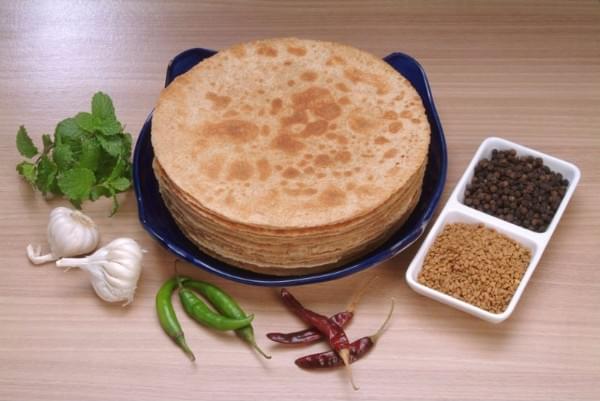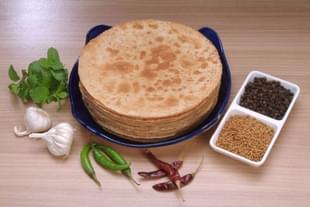Culture
There Is Nothing Ordinary About Khakhra. Ask Arun Jaitley.
Ratna Rajaiah
Oct 15, 2017, 11:41 AM | Updated 11:41 AM IST
Save & read from anywhere!
Bookmark stories for easy access on any device or the Swarajya app.


The trouble with an oral tradition, and that too one as ancient as India’s, is that its history is often difficult to access, especially culinary history. So, while you will find reams of paper and hundreds of books about the piffling 400-year-old pumpkin pie, the earliest documented historical reference to the idli is in 920 AD.
And the khakhra? That now-ubiquitous, impossibly thin and crisp, even more impossibly perfect circle of deliciousness that is a Gujarati (oh alright, Marwari as well, but you’ll have to admit that the greater claimants are Gujarati) snack, that in English, we dare to insult with the descriptor “cracker”?
Well, let’s see now.
I think it was about portability. Also thrift. But mainly three cups of portability to one spoon of thrift.
The Gujaratis are a people with a long tradition of being portable. Before anyone takes umbrage to that, let me explain. They have a very old habit of traipsing off to far away foreign lands – mainly to trade and often to make these places their home. And since if they went north, south or east (which incidentally they also did), they’d remain in India, they had to cross the Arabian Sea, a daunting proposition since it was in times when going from Ahmedabad to your chacha’s home in Mehsana meant at least a week by bullock cart. Longer by foot.
But it is not for nothing that the Gujaratis have a reputation for being one of India’s oldest and greatest business classes. Virji Vora (1590-1670) – records describe him as the richest merchant in the world – once sold 12,000 tolas of gold to the English and bought 800kg of tea from the Dutch. So, a mere ocean, however vast and uncharted, was “pshaw” to the daring, enterprising Gujaratis, and soon, they had made their way almost all around the globe – Africa, Europe, the Middle East, the Far East.
Now, a large majority of the Gujarati merchants were vegetarian, many of them Jains (like Vora) who had to adhere to strict food laws. So they must have had to carry their food with them, food that was vegetarian and, more importantly, food that would not spoil over months of travel, often in moisture-laden, salty sea air.
Now, before chemical preservatives came along, there were two traditional ways to preserve food. One was to keep the bacteria at bay by drowning the food in a sea of acidity and salt. Or sugar. As we do with pickles and murabbas. The other was to banish every iota of moisture so that the food was too dry for any bacteria to dare to even think of breeding in it. And that is exactly what a khakhra is. A roti pressed into a hot tava to go so dry that for months it stays fresh as the day Induben took it off her tava.
And this is the thrift part bit, because initially, khakhras were made of leftover rotis. Now, of course, with a global demand for millions of them, in flavours ranging from the good old regular to stuffed chocolate, it is a different story.
So, the khakhra probably started off many centuries ago as the Gujarati’s travel food. And it is likely that along with the cargo of turmeric and cardamoms, he had to sell to the English, it must be one of the things that Vora had in his ship’s hold. In other words... dare I say this?... the khakhra probably played a key role in the fact that the Gujarati business diaspora has now spread to 129 of the 190 nations of the world.
And that, in short, is the history of the khakhra. Do I have documented evidence to prove any of this? Of course not. But it could very well be the case.
If Arun Jaitley had agreed, he’d have thought twice before slapping a whopping 12 per cent goods and services tax (GST) rate on the khakhra, treating it like just another namkeen. Because it’s not, the ensuing uproar was immediate, deafening and understandable. Actually, all he had to do was check with his boss. Who, from all indications, is a khakhra aficionado. Naturally, you scoff – he’s a Gujarati, he has to be. Wait.
When Narendra Modi addressed the twenty-ninth annual session of the ladies wing of the Federation of Indian Chambers of Commerce & Industry in New Delhi in 2013 (though he was still Gujarat chief minister, he was addressing a national audience), while talking the potential power of the Indian woman entrepreneur, he chose two women as examples. One of them was Induben Khakhrawala. Originally she was Induben Jhaveri, who started making and selling khakhras to support her family when her husband fell ill and which sold like hot khakhras and soon became so popular that she changed her surname to “Khakhrawala”. One of the most popular, must-visit stores in Ahmedabad became – and still is – Induben Khakhrawala.
What I mean to say is, the khakhra is no ordinary namkeen and needs to be treated as such. Fortunately for us – and him – Jaitley has now reduced the GST to a more respectful 5 per cent, the rate applicable also to, among other things, real zari and life-saving drugs.
Enough said. Except for one last thing.
There is one area where the khakhra has competition from its thicker, flabbier, greasier but equally delicious sibling – the thepla; the very thing that makes it so unique – its thin crispness also makes the khakhra very fragile. But, remember that its ancestry is Gujarati, and Marwari, both of whom are nothing if not experts in innovativeness, especially in sticky situations. So, there is use even for a crumbled, disintegrated khakhra, and I found it printed on the pack of my favourite brand – Daadi’s. Just put the crumbled bits into a bowl, add sugar and hot milk, and voila – you have a great desi version of cornflakes.
Jai khakhra!
-- Ratna Rajaiah is an author and a columnist. She lives and cooks in Mysore.




